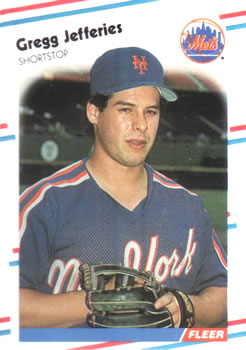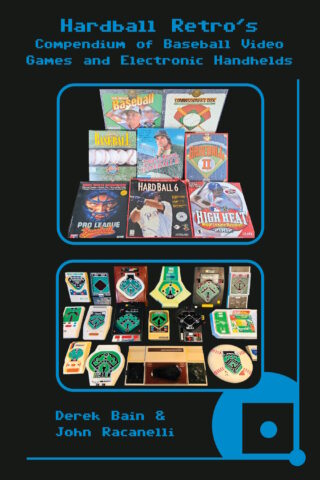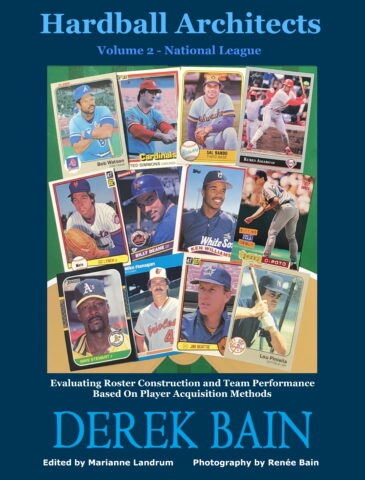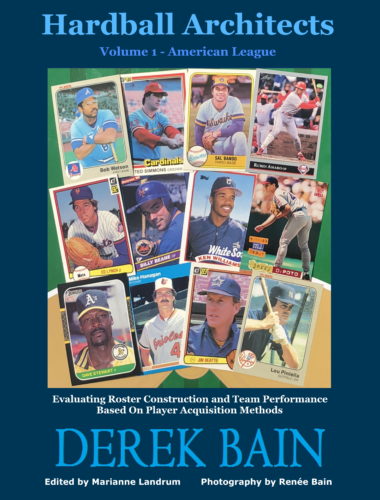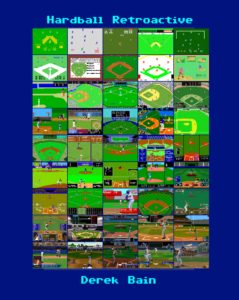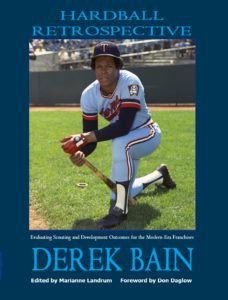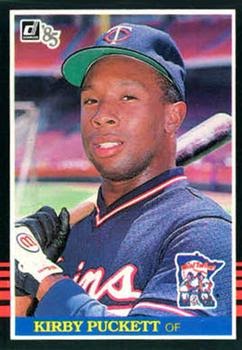
The 1985 Donruss Baseball Card Set
Derek’s (Re)collections
The calendar turned to 1985 and I was knee-deep in my baseball card collection. I subscribed to the Beckett Baseball Monthly Price Guide and purchased several binders with sleeves to display nine cards per page along with hard plastic holders and cardboard boxes to keep my collection in pristine condition. My friends and I visited the local card shop several times a week, anticipating the arrival of the ‘85 cards. The “Rookie Card Craze” was in full effect and living in the vicinity of New York, everyone was eager to get their hands on the first regular-series “Doc” Gooden cards. By mid-season it was clear that “Dr. K” was dominating the National League and the value of his cardboard likeness skyrocketed accordingly. Swept up in the moment but short on funds, I started to backfill my collection with individual pre-1984 cards. Any remaining funds that I could scrape together went towards wax pack purchases.
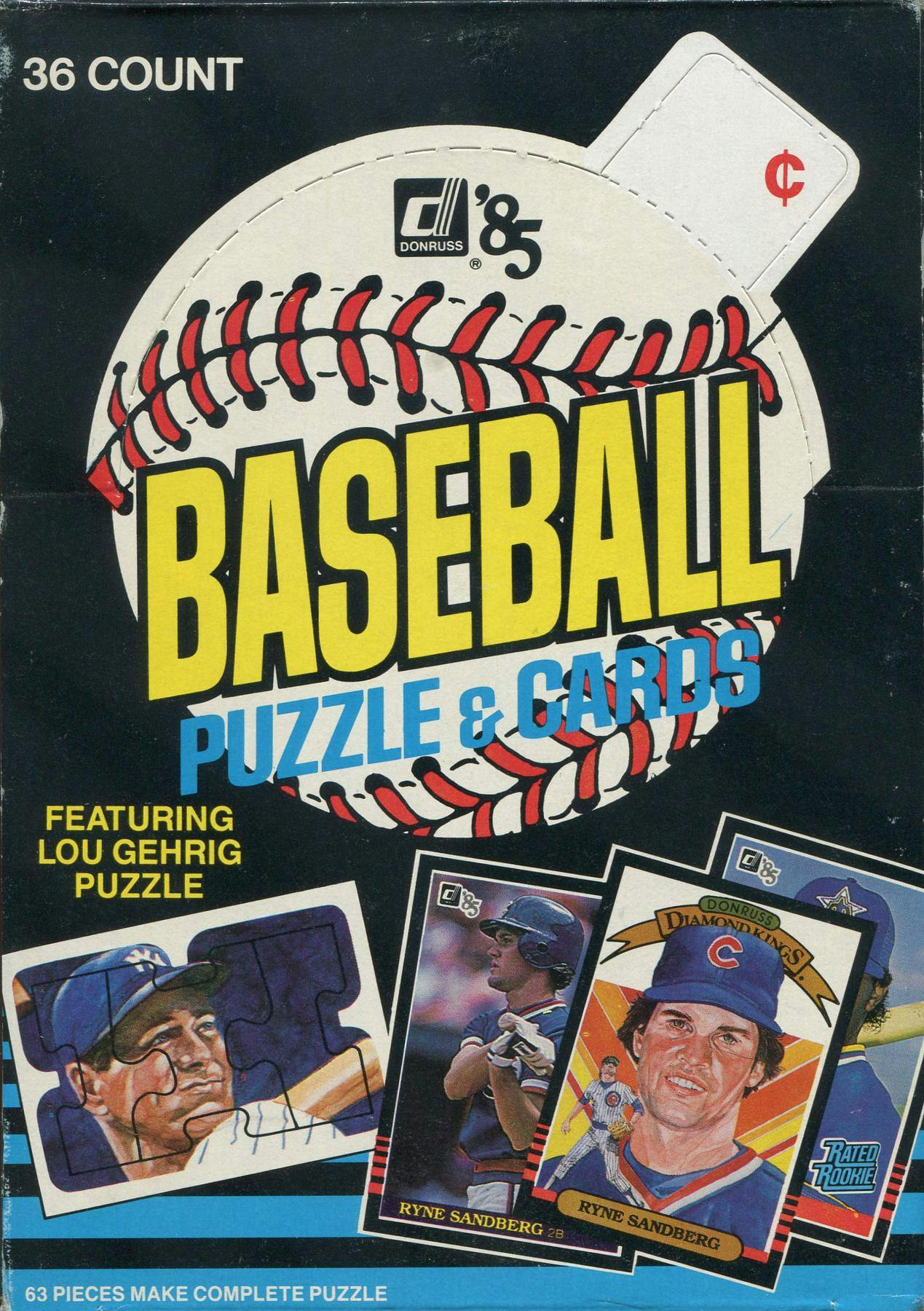
Corby Corner
So here it is, what I personally believe to be the best year of baseball card collecting, from the cards themselves, to the players that graced those beautiful prints. 1985 was also the year I went 100% full tilt into playing baseball, watching it and collecting cards. Life revolved around the sport, and the outcome of each California Angels game could swing my mood in a flash. My parents can vouch for that.
The 1985 Donruss set was now their second in a row that could be argued for the best overall in their competition with Topps and Fleer. This year’s Donruss set was also the first factory set I ever purchased. I was especially intrigued by the “Rated Rookies” feature added on to certain first year players that Donruss had deemed worthy, though if memory serves correctly, not too many of them saw success in the majors. They missed on some big names in there; Hershiser, Puckett, and Clemens come to mind…more on Roger when we get to 1985 Topps!
Favorite Cards
Tom: Roger Clemens (#273) – I bought about 20 of his rookie cards; loved the Donruss card the most.
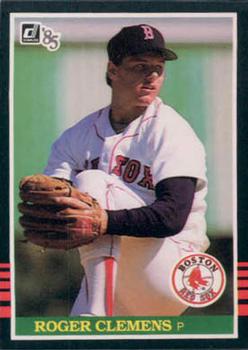
Derek: Dennis Eckersley (#442) – This one captures the “Eck” motion perfectly.

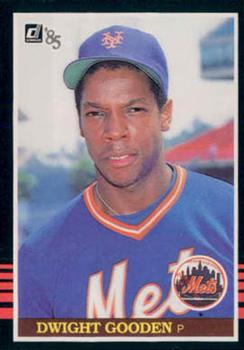
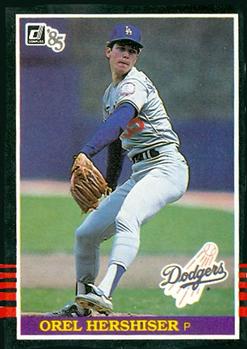
Features
The standard Donruss baseball card set from 1982-1989 consisted of 660 cards. Continuing a tradition rooted in their sophomore effort, the 1985 Donruss set commences with a subset of 26 Diamond Kings rendered by artist Dick Perez (#1-26). Ryne Sandberg (#1), Don Mattingly (#7), Cal Ripken Jr. (#14) and Tony Gwynn (#25) achieved “DK” status in ‘85 and the popular series lasted 15 seasons. Danny Tartabull, Shawon Dunston and Billy Hatcher made their cardboard debuts among the 20 Rated Rookies (#27-46). Yankees teammates Don Mattingly and Dave Winfield’s battle for the batting crown is chronicled in card # 651, “Two for the Title”. Card # 635 shows a completed version of the Lou Gehrig puzzle (3 pieces of the puzzle are inserted into each wax pack).
A black border is accentuated with a series of 5 red stripes towards the bottom of each card with the Donruss logo and the year in the top left corner. The player’s name and primary position are printed in uppercase below the action or portrait photo. Similar to their previous year’s effort, the photography in the 1985 Donruss set is top-notch. The flip side lists the card number inside a baseball and details the ballplayer’s biographical information across the upper section. The center encompasses yearly statistics from the past five seasons (if applicable) and career totals while the bottom section summarizes career highlights along with contractual status and an account of how the player was acquired by his current club. Black text is printed over a yellow background with the exception of the player statistics in the center which employs a white background for contrast.
The Action All-Stars set returned for the third consecutive season featuring 60 cards in a larger-than-standard format (3 ½” by 5”). A headshot along with an in-action photo of each player also distinguishes this set from the standard ‘85 issue. The Donruss Highlights subset (56 cards) debuted in 1985 along with HOF Sluggers (8 cards) and Super DK’s (28 cards). The Highlights series ran for three years (85-87) chronicling the players and pitchers of the month for each league along with in-season highlights from the ‘85 campaign. Available through a mail-in offer from 1985 to 1991, the Super Diamond Kings measured 4 15/16” x 6 ¾” and mimicked the Diamond Kings subset from the standard-issue set. The subset values according to the 1997 edition of the Beckett Almanac of Baseball Cards and Collectibles are as follows: Action All-Stars $6, Highlights $15, HOF Sluggers $7, Super DK’s $15.





One-and-Dones
The players listed below made their lone appearance on a regular-issue baseball card in the 1985 Donruss set.
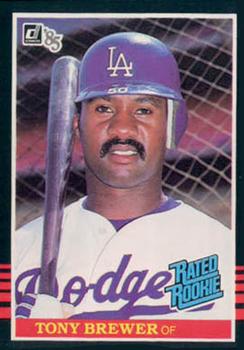
Tony Brewer (#31) – The corner outfielder reached the Majors with the Dodgers in August 1984 after signing with the club as an amateur free agent 5 years earlier. Ascending through the system, Brewer garnered a promotion after posting a .357 BA and slugging .588 in his second campaign with the Albuquerque Dukes (AAA). Brewer played in 24 MLB contests primarily as a pinch-hitter. Manager Tommy LaSorda penciled him into the starting lineup on August 24, 1984 after seven hitless at-bats off the bench since the first of the month. Opposing Al Holland in the eighth inning, Brewer rapped a two-base hit to knock in Dave Anderson with the tying run to notch his first MLB hit. Facing the Giants on the final day of the season (September 30, 1984), Brewer belted his lone big-league homer in the seventh frame off right-hander Mark Calvert. In a touch of irony, neither player appeared in the Majors after that date. Returning to the Dukes in ‘85, Brewer slumped to a .265 BA with 10 dingers and inked a deal in 1986 to play overseas with the Nippon Ham Fighters in the Japan Pacific League. Through 4 years in the Land of the Rising Sun, Brewer averaged .307 with 25 four-baggers and a .521 SLG. Brewer’s brother Mike also received a cup of coffee when he earned a call-up in June 1986 with Kansas City where he registered 12 games and 18 at-bats.

Charlie Mitchell (#40) – A fourth-round selection in the January 1982 Amateur Draft, Mitchell rapidly ascended through the Boston farm system and merited a call-up in August 1984 after notching 10 wins and 15 saves along with a 2.11 ERA for Pawtucket (AAA). Pete O’Brien greeted him with a deep fly ball into the seats at Arlington Stadium in his first MLB outing on August 9, 1984. Mitchell fared better in a September 14, 1984 match at Yankee Stadium, hurling 3 scoreless frames against the Bronx Bombers. The right-hander pitched in 12 games (all in relief) over a 2 year period (1984-85) for the Red Sox yielding an ERA of 4.00. In his final big league appearance on September 10, 1985, Mitchell relieved Bruce Kison with the Sox trailing 7-1 and allowed a single by Cal Ripken, Jr. before escaping further damage when he induced Eddie Murray to hit a grounder back to the box. Dealt to Minnesota in exchange for outfielder Mike Stenhouse in December 1985, he toiled primarily in a relief role for the Toledo Mud Hens (AAA), Glens Falls Tigers (AA) and Nashville Sounds (AAA) through the ‘91 campaign but never returned to the big leagues. Following a 4 year hiatus from professional baseball, Mitchell crafted a 1.57 ERA with a WHIP of 0.942 during a pair of independent-ball seasons with the Columbia Mules. His brother John started 37 games for the Mets and Orioles in parts of 5 seasons from 1986 to 1990 where he compiled a record of 9-14 with a 4.35 ERA.
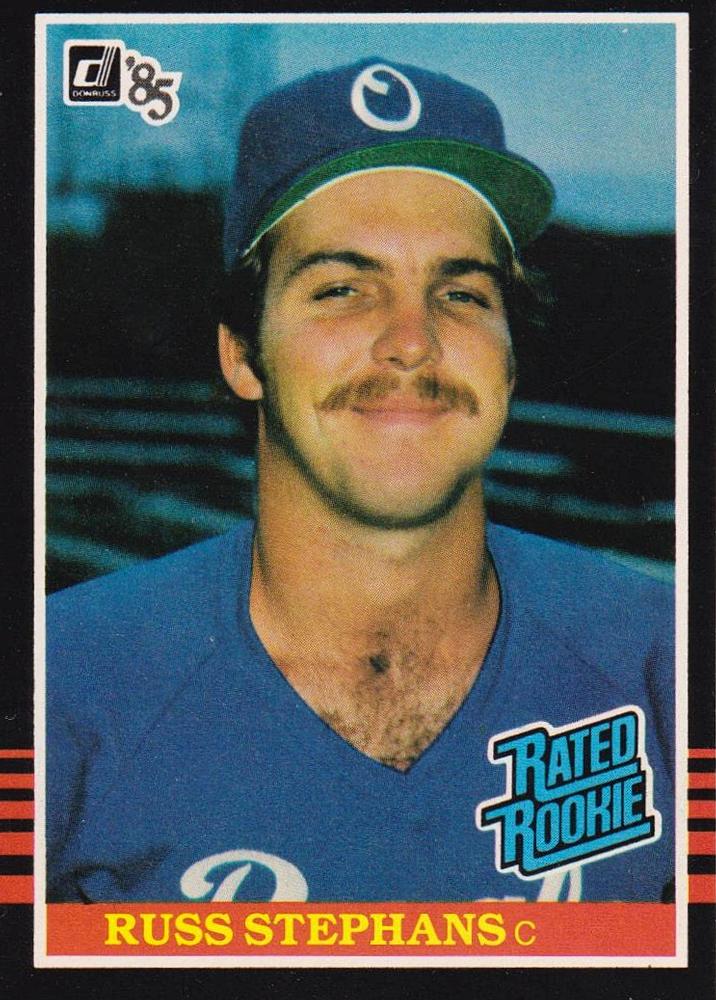
Russ Stephans (#42) – Taken by the Royals in the third round of the June 1980 Amateur Draft (Secondary Phase), Stephans compiled a .266 BA over 7 minor league campaigns. He spent his final four seasons (1983-86) with the Omaha Royals (AAA) and established personal-bests when he slashed .290/.388/.452 with 21 two-baggers and 9 jacks in 1984. Stephans left pro ball after his offensive output slipped to .202 in 84 at-bats in ‘86.

Doug Loman (#46) – Milwaukee chose Loman with the second pick in the January 1978 Amateur Draft (Regular Phase). He averaged .265 with 22 doubles and 12 stolen bases through 6 minor league seasons (1978-1983). Loman finally mastered Triple-A on his fourth attempt, generating career-highs in batting average (.324), doubles (34), RBI (102), runs (79) and slugging percentage (.527) to warrant a call-up to the Majors in September 1984. Slotted into the lineup in a full-time role as the left fielder, Loman delivered a .276 BA and coaxed 15 walks to register a .402 OBP. In his first big-league game (September 3, 1984) he drilled a double off Dennis “Oil Can” Boyd in the fourth inning and singled two innings later to knock in a run. The lefty-hitting Loman launched a pair of solo shots off Roy Lee Jackson and Jimmy Key to vault the Brewers to an 8-5 victory over the Blue Jays on September 23, 1984. Rewarded with a start in center field on Opening Day in 1985, Loman played sporadically and logged a .212 BA prior to being demoted in mid-May. He legged out a triple against Ron Romanick in the bottom of the fourth inning of an eventual 5-4 loss to the Angels on May 10, 1985 for his final big league hit. Back in Vancouver (AAA), Loman compiled a .294 BA with 23 doubles and 10 dingers. Released by the Brewers in September 1985, he signed with the Yokohama Taiyo Whales (Japan Central League) in 1986 where he supplied a .291 BA with 26 two-baggers, 14 jacks and 75 ribbies during his last season in pro ball.

Scottie Earl (#491) – A September call-up during the Tigers’ dominant 1984 campaign, Earl got into 14 contests for the eventual World Champions in his age-23 season but never appeared in a Major League game again. A fourteenth-round pick by Detroit in the June 1981 Amateur Draft, the second-sacker ascended one level at a time during his minor league apprenticeship. Swiping 33 bags and tallying 88 runs annually over a 5 year stretch (1982-86), Earl’s on-base skills merited a promotion to the Motor City. He entered 4 games as a pinch-runner or defensive replacement before receiving his first start on September 19, 1984. Playing at home against Milwaukee and batting leadoff, Earl laced a triple off Tom Candiotti in his second at-bat to drive in Doug Baker and increase Detroit’s advantage to 3-1. The three-bagger turned out to be his lone extra-base hit and RBI in the Major Leagues. Earl stroked a single off Ron Guidry in a match on September 29, 1984 to snap an 0-for-19 skid. With the Tigers ahead 11-1 in the ninth frame, he rapped a base knock off Clay Christiansen for his final big-league hit. In the last regular season contest, Earl substituted for Tom Brookens in the fifth inning and went hitless in two at-bats. Facing reliever Mike Armstrong in the top of the eighth, he hit a harmless pop fly to Yankees’ second baseman Rex Hudler to drop his batting average to .114 (4-for-35). Earl soldiered on as a middle infielder for the Tigers’ Triple-A affiliates over the next 3 campaigns but failed to hit above .250. After putting up similar numbers for the Nashville Sounds (AAA) in the Reds’ farm system during the ‘88 season, Earl split time between the Toledo Mud Hens (AAA) and the Columbus Clippers (AAA) in 1989 before calling it quits.

Ralph Citarella (#504) – The Cardinals’ first pick in the Secondary Phase of the June 1979 Amateur Draft, Citarella crafted a 4.06 ERA along with a 1.241 WHIP across 21 big-league appearances (19 in relief). In 1980 during his first full season with the Gastonia Cardinals (A) he fashioned an ERA of 1.64 with a WHIP of 1.079 while racking up 11 victories and 8 saves. Spending nearly the entire ‘81 campaign with the Arkansas Travelers (AA), Citarella (8-9, 3.82) divided his outings evenly between starting and relief assignments. He prevailed in 15 of 21 decisions with the Louisville Redbirds (AAA) in ‘82 despite an ERA of 4.88 and a WHIP north of 1.5. Pitching in a variety of roles while repeating Triple-A in 1983, Citarella received a call to the Majors with the expansion of rosters in September even though his results were nearly identical to his output from the previous campaign. Making his debut for St. Louis, the fourth hurler in a 6-0 loss to Pittsburgh on September 13, 1983, Citarella retired 5 of the 6 batters he faced, yielding a one-out double to Johnny Ray in the seventh inning. Eleven days later in relief of Dave LaPoint, the right-hander twirled 5 scoreless innings and permitted a lone safety against the Phillies. Through 6 relief appearances spanning 11 innings, he allowed only 8 hits and a couple of earned runs (1.64 ERA). Citarella commenced the following season in Triple-A again, where he racked up 9 victories in 11 decisions along with a 3.91 ERA in 16 games (14 starts). The Cardinals called upon him in mid-June and after a one-inning relief stint in his first outing, he was slated to start against the Cubs at Wrigley Field on June 23, 1984 in a matchup that became known as the “Sandberg Game”. Staked to a 7-1 lead highlighted by a Willie McGee 3-run triple off Steve Trout, Citarella left the contest with a 9-3 advantage in the bottom of the sixth. He watched his potential first MLB win evaporate into the Windy City breeze as his replacement, Neil Allen, yielded a walk and three successive hits as the Cubbies closed the gap to 9-8. Ryne Sandberg provided the fireworks for the hometown faithful with a leadoff homer in the bottom of the ninth off Bruce Sutter. St. Louis stormed back with 2 runs in the top of the tenth to assume an 11-9 lead. “Ryno” delivered another blow with a two-out, two-run blast off Sutter in the home half of the tenth to knot the score at 11-all. Leon “Bull” Durham ignited the winning rally when he coaxed a walk to start the eleventh inning, swiped second and advanced to third on a Darrell Porter throwing error. Jeff Lahti relieved Dave Rucker and issued intentional passes to Keith Moreland and Jody Davis. Dave Owen stepped to the dish with the bases juiced and laced a single to right to drive in Durham for a 12-11 comeback victory. Four days later Citarella pitched well but suffered a loss in a start against the Expos by a 4-2 margin. Caveats for small sample size aside, Citarella thrived again out of the bullpen (11 IP, 0.82 ERA) while struggling to a 6.35 ERA in a pair of starting assignments. Philadelphia purchased his contract in January 1985 and he languished in Triple-A for the next 3 campaigns while fashioning a composite ERA of 4.67 for Portland, Tacoma, Louisville and Hawaii. His perseverance was rewarded with a 5-game stint with the White Sox in the summer of ‘87. Citarella yielded runs in each of his first 4 outings including a trio of gopher balls to Ruppert Jones, Devon White and Wally Joyner in a 13-3 rout by the Angels on June 28, 1987. On the bubble and possessing an ERA of 11.57 following a deep drive into the left field seats by Joe Carter on July 3, Citarella responded with 4 scoreless innings one week later. Trailing the Yankees 9-4 in the bottom of the fifth, he scattered 3 hits and a walk to hold the Bronx Bombers at bay. The Pale Hose lost the game but Citarella whiffed the final big-league batter that he faced, Dave Winfield, in the bottom of the eighth. In 1988 he pitched in 8 games for the Brewers’ Double-A affiliate, the El Paso Diablos, and spent some time with the independent Fresno Suns (A) where he notched 7 saves with a 1.80 ERA before hanging up his spikes.
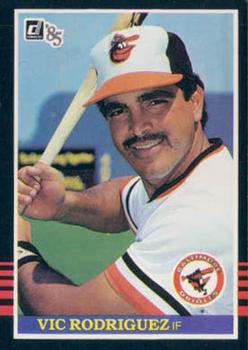
Vic Rodriguez (#535) – Baltimore inked Rodriguez to a contract as a 15-year-old amateur free agent in February 1977. Through five minor league campaigns as a teenager, Rodriguez batted at a .305 clip. He drilled 23 doubles in the upper minors during the ‘82 season but posted his lowest BA, OBP and SLG as a professional. A full season at Charlotte (AA) in 1983 restored his confidence as Rodriguez produced a .298 BA with 26 two-baggers along with career-bests in home runs (14), RBI (77) and runs scored (80). In his eighth year as a minor leaguer but still only 22 years old, Rodriguez performed slightly better during his second stint with Rochester (AAA) and the Orioles responded by calling him up to the big leagues in September 1984. Manager Joe Altobelli deployed him as a pinch-runner on three occasions before inserting him as a defensive replacement at second base for Rich Dauer in the fifth inning of a blowout on September 18, 1984. The Orioles trailed the Yankees 8-0 and Rodriguez whiffed in his first at-bat against southpaw Ray Fontenot. In the top of the ninth he delivered a base hit off right-hander Clay Christiansen. Two days later, Rodriguez was penciled into the starting lineup for the first time, batting ninth and playing second base at Memorial Stadium in Baltimore. Nipper retired Rodriguez twice in the early frames but struggled mightily as the O’s tallied 8 runs in the first four frames. He joined the party with a base knock off Sox reliever Jim Dorsey in the fifth and then rocked a pair of doubles, notched his first big-league RBI and scored twice later in the contest against Mike G. Brown. Rodriguez registered two hits including a double off Oil Can Boyd in the final game of the year to finish with a .412 BA (7-for-17). Traded to the Padres in February 1985 for Fritzie Connally, Rodriguez rapped 31 doubles and batted .312 at Las Vegas. He spent the remainder of the Eighties playing Triple-A ball with the Louisville Redbirds (AAA) and the Portland Beavers (AAA) with the exception of 6 games in July 1989 with the Twins. In the midst of compiling a .314 BA with 34 two-base hits in the Pacific Northwest, Rodriguez merited a call-up to Minnesota. Manager Tom Kelly slotted him into the lineup on July 21, 1989 while granting a day off to third baseman Gary Gaetti. Rodriguez lined a single to left in the opening frame off portsider Teddy Higuera and finished the day with one hit in four trips to the dish. One week later in the second game of a doubleheader in Detroit, Rodriguez delivered a pair of knocks including a double off Tigers’ reliever Ramon Pena. He scored the go-ahead run on a Kirby Puckett base hit as the Twins triumphed 7-3. Two days later he entered a contest as a defensive replacement and faced Pena again in the top of the ninth with Minnesota ahead 9-3. With one out and Tim Laudner on first base, Rodriguez stepped to the plate unaware that this would be his final at-bat in the Majors. He promptly ripped a line drive to deep left sending Launder to third and came around to score later in the inning on a two-base hit by Doug Baker. Rodriguez finished the ‘89 campaign with a .455 BA (5-for-11) for the Twins and his MLB career stat line read as follows: .429 BA (12-for-26) with 5 doubles and 6 runs scored. Missing most of the 1990 season and recording only 41 plate appearances at Portland, he played in 83 games in ‘91 for the same ball club and contributed a .304 BA. Rodriguez spent four more years in Triple-A including a stint with Olmecas de Tabasco (Mexican League) in ‘92 before riding off into the sunset after the 1995 campaign to cap a 19-year career as a professional ballplayer.
Did You Know?
Donruss included interesting facts about some of the players on the bottom section of the card backs.
Reggie Jackson (#57) – “‘Mr. October’ owns .357 avg. for 5 World Series including 3 HR in final game of ‘77 Classic with Yankees vs. Dodgers.”
Kent Hrbek (#70) – “Hit 12th inning HR to beat Yankees at Yankee Stadium in first major league game 8/24/81.”
Joel Youngblood (#79) – “Became 1st player in big league history to get hits with 2 different teams (Mets and Expos) on the same day 8/4/82.”
Mike Witt (#108) – “Hurled a perfect game final day of ‘84 season vs. Rangers, only 12th player in history to accomplish the feat.”
Tim Stoddard (#144) – “Signed originally by White Sox out of North Carolina St., where he was a member of the Wolfpack’s ‘74 NCAA basketball championship team.”
Sammy Stewart (#148) – “Set a major league record for most consecutive strikeouts (7) in 1st major league game 9/1/78.”
Tito Landrum (#168) – “Has worked as a male model in off-season.”
Dwight Gooden (#190) – “Broke Herb Score’s major league record for most strikeouts by a rookie last year, a mark that had stood since 1955.”
Bryn Smith (#203) – “Is a 3-handicap golfer.”
Len Matuszek (#259) – “Made baseball history 6/1 last year when, vs. Cubs, he became only 8th player ever to play an entire game at 1B without making a putout.”
Willie Wilson (#297) – “Became only 2nd player in major league history to achieve 100 hits from each side of the plate in ‘80.”
David Green (#303) – “Was a track star as a youngster in his native Nicaragua.”
Errors
There are several significant “error” cards in the 1985 Donruss baseball set. Left-hander Floyd Bannister makes an appearance on Tom Seaver’s card (#424). The corrected version presently sells in the $10 range. Terry Pendleton’s rookie card (#534) inexplicably listed his first name as Jeff. The amended version retains higher value due to the shorter production run. Several uncorrected error cards depicted the wrong player photo on the front of the card:
George Frazier’s photo on Ernie Camacho’s card (#129)
Frank Wills’ photo on Danny Jackson’s card (#374)
Mike G. Brown’s photo on Al Nipper’s card (#614)
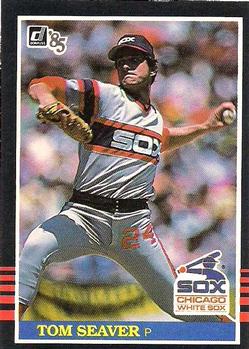




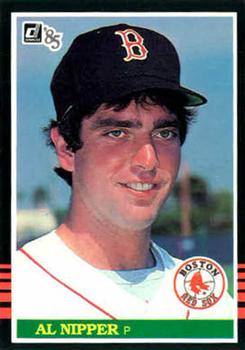
Rookie Cards
Kirby Puckett, Roger Clemens, Dwight Gooden, Terry Pendleton, Orel Hershiser, Eric Davis, Bret Saberhagen and Danny Tartabull highlight the list of players making their cardboard debuts in the ’85 Donruss set.
Price Guide (Then and Now)
The “Beckett Baseball Card Monthly Price Guide” (November 1985 edition) lists the 1985 Donruss Baseball complete set for $24. Individual cards listing for at least one dollar included Dwight Gooden (# 190, $4.50), the corrected version of Tom Seaver (# 424B, $4) and Terry Pendleton’s (# 534B, $2) cards, along with the Dwight Gooden card on the underside of the wax boxes (# PC1, $3). The Puckett card (graded PSA 8) currently sells in the $20-$30 range.
Please add a comment below if you would like to share any memories from collecting the 1985 Donruss baseball card set or your experiences with card collecting in general!
Articles in the Series
References and Resources
Beckett, Dr. James, Rich Klein and Grant Sandground. Beckett Almanac of Baseball Cards and Collectibles. Dallas, TX: Beckett Publications, 1997. Print.
Beckett.com (requires subscription to view prices):
https://www.beckett.com/search/?term=1985+donruss&year_start=1985
http://www.tuffstuff.com/priceguides
http://www.baseballerrors.com/
Trading Card Database – Photo Gallery
https://www.tcdb.com/Gallery.cfm/sid/100/1985-Donruss
About the Authors
Derek Bain is a New Jersey native with a passion for baseball, statistics, computers and video games who enjoys spending quality time with his family.
Tom Corby – Cousins with Derek, I am a history teacher at New Egypt High School. I have three kids, Addison, Jaclyn, and Mason and I’m happy that I get to coach them in their sports as well. In my spare time I enjoy reading, anything beach related, and fishing when time allows.
Derek’s Books
“Hardball Architects – Volume 1 (American League Teams)”, published in July 2020, is available in paperback and digital (Kindle) format at Amazon.com.
“Hardball Architects – Volume 2 (National League Teams)”, published in April 2022, is available in paperback and digital (Kindle) format at Amazon.com.
Hardball Architects examines the trades, free agent acquisitions, draft picks and other transactions for the 30 Major League Baseball franchises, divided into a 2-volume set (American League and National League). All key moves are scrutinized for every team and Sabermetric principles are applied to the roster construction throughout the lifetime of the organization to encapsulate the hits and misses by front office executives.
“Hardball Retroactive”, published in June 2018, is available in paperback and digital (Kindle) format at Amazon.com. Hardball Retroactive is a modest collection of selected articles that I have written for Seamheads.com along with my Baseball Analytics blog since 2010. Exclusive content includes the chapter on “Minors vs. Majors” which assesses every franchise’s minor league successes and failures in relation to their major league operations.
“Hardball Retrospective” is available in paperback and digital (Kindle) format at Amazon.com. Supplemental Statistics, Charts and Graphs along with a discussion forum are offered at TuataraSoftware.com. In Hardball Retrospective, I placed every ballplayer in the modern era (from 1901-present) on their original teams. Using a variety of advanced statistics and methods, I generated revised standings for each season based entirely on the performance of each team’s “original” players. I discuss every team’s “original” players and seasons at length along with organizational performance with respect to the Amateur Draft (or First-Year Player Draft), amateur free agent signings and other methods of player acquisition. Season standings, WAR and Win Shares totals for the “original” teams are compared against the real-time or “actual” team results to assess each franchise’s scouting, development and general management skills.
Don Daglow (Intellivision World Series Major League Baseball, Earl Weaver Baseball, Tony LaRussa Baseball) contributed the foreword for Hardball Retrospective. The foreword and preview of my book are accessible here.
“Hardball Retrospective – Addendum 2014 to 2016” supplements my research for Hardball Retrospective, providing retroactive standings based on Wins Above Replacement (WAR) and Win Shares (WS) for each “original” team over the past three seasons (2014-2016). Team totals from 2010 – 2013 are included for reference purposes. “Addendum” is available in paperback and digital (Kindle) format at Amazon.com.

